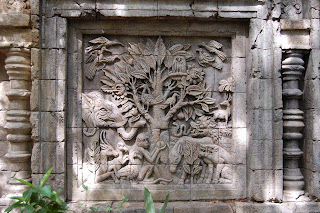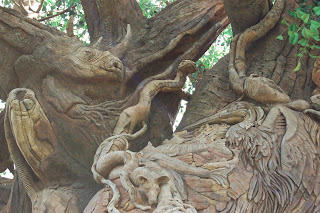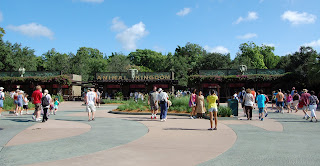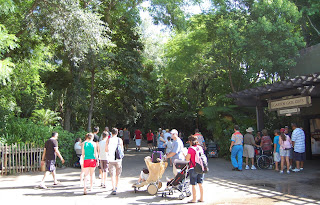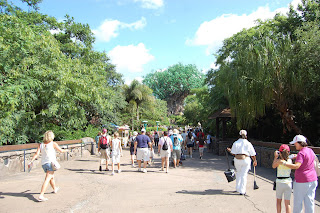When it opened in 1998, Disney's Animal Kingdom was billed as "A New Species of Theme Park." It certainly lives up to that. From the very beginning, the park was designed to give Walt Disney World Guests a different experience from that offered in the other, more traditional Disney Parks. The Imagineers wanted Guests to become immersed in the park, surrounded by a world of animals and completely removed from the outside world.
The experience starts in the parking lot. Here, though, we are presented with exactly what we expect: barren concrete and plain grass medians. It's important that this area be wide open. We are meant to be surrounded by cars, buses and trams - creations of the human world.
As we get closer to the entrance plaza, things start to change very subtly. In the distance, we can see an immense forest. The pavement at our feet starts to become more interesting. There's color and the hint of swaying branches, leading us forward. There's architecture here, too, bold and out front. On the faces of the structures are images of animals created by human hands, but we still don't see real animals. We are definitely still in a theme park environment we expect.
Just past the ticket booths, as we approach the turnstiles, things really start to change. The architectural style chosen for this area is Craftsman, for its earth-tone colors and use of natural materials. Notice, though, how the tree in the foreground is contained in a planter, but just beyond we see that nature is breaking free and growing up and around the side of the building, completely enveloping it.
Once through the turnstiles, there are no planters at all. We are in a natural environment, where the "dirt" paths brush right up against the vegetation:
There are one or two small structures, then nothing but trees - an oasis of nature in the middle of the hustle and bustle of Walt Disney World. Here is where Disney's Animal Kingdom completely breaks from the norm. Instead of being presented with a direct avenue of shops leading to a central icon, our forward march stops. In front of us is pure nature: trees, water, birds, and paths wandering in different directions.
The goal is to get us to slow down, take our time and appreciate the world around us. It's to create a sense of exploration, of discovery. Admittedly, some Guests visiting the park aren't quite as adventurous. For them, directional signs have been added to the area over the years, but their design has been kept subdued so as not to conflict with the surroundings.
Those with a sense of adventure are rewarded here. Sure, the main path up each side of the Oasis ultimately leads to Discovery Island and the rest of the park, but there are many side paths. Along them can be found all sorts of delightful animals (wallabies, rhinoceros iguana, macaws, muntjacs) and a few spectacular surprises like this waterfall:
Or this suspension bridge, leading to a dark and mysterious cave (one of the favorite places for me and my little boys):
Eventually, whether you follow the herd or take the path less traveled, the Oasis opens up to a spectacular view of the Tree of Life. It's still in the distance, inviting us to explore further, but already we feel a sense of accomplishment. Our initial adventure is complete, and we've arrived at this place of wonder and enchantment - a place fully detached from the world of parking lots and bus depots we left behind.

